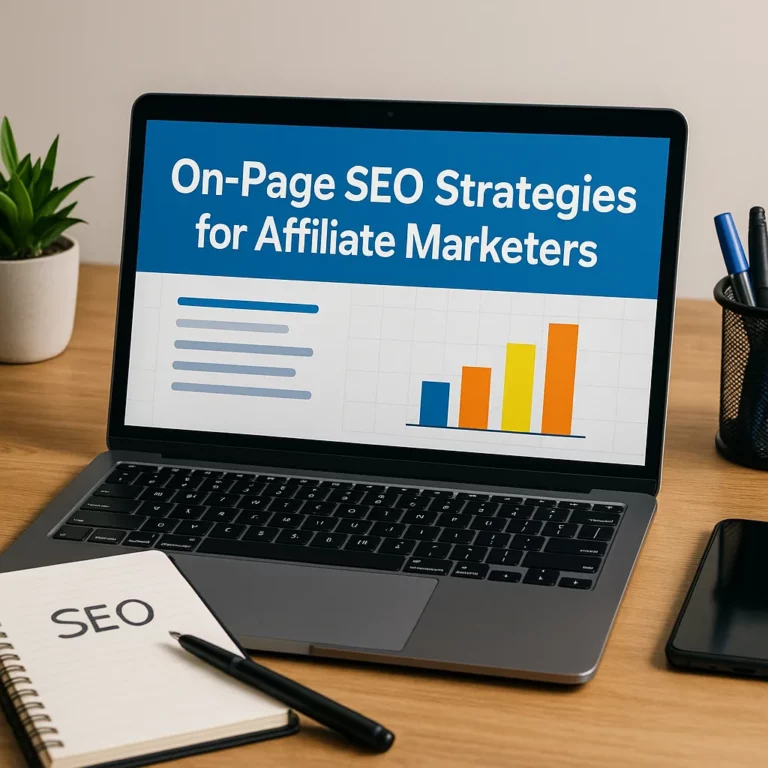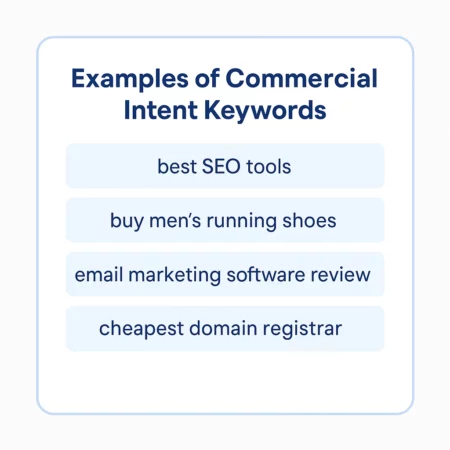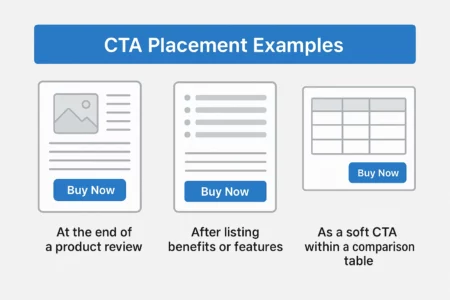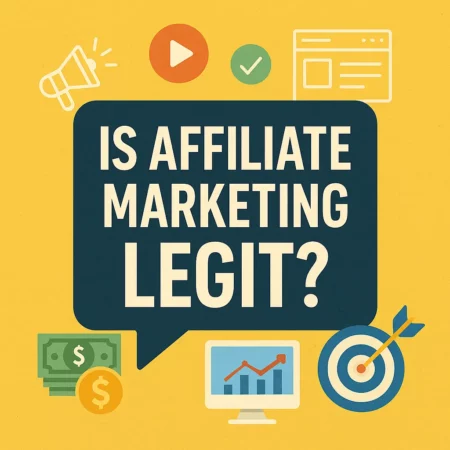If you want your affiliate site to rank higher, earn more, and grow faster, mastering on-page SEO for affiliate marketing is non-negotiable. It’s the difference between content that quietly fades into the background and pages that actively bring in traffic and commissions day after day.
But affiliate marketers face unique challenges. From managing outbound links to optimizing product-heavy content, on-page SEO requires a more strategic approach than standard blogging or business websites.
In this guide, you’ll learn 7 proven tactics that will help you optimize every page for both search engines and conversions. Whether you’re starting from scratch or fine-tuning your existing site, these on-page strategies will help you rank smarter, boost your visibility, and get the most from every click.
Let’s get started.
What Is On-Page SEO (and Why It Matters for Affiliates)?
On-page SEO refers to the elements you can control directly on your website to improve its visibility in search engines. This includes optimizing your content, structure, meta tags, internal links, images, and more. For affiliate marketers, on-page SEO isn’t just about driving traffic. It’s about attracting the right kind of visitors who are ready to take action.
Unlike traditional websites, affiliate sites face unique challenges. You’re often competing in highly saturated niches, working with limited product descriptions, and balancing helpful content with monetization. This makes affiliate SEO a more strategic, trust-focused process.
Affiliate content also includes multiple outbound links, which can weaken page authority if not managed carefully. That’s why every on-page element, from keyword placement to link structure, needs to work together to support rankings while also building reader trust.
If you’re just starting out, take a look at Affiliate SEO Made Simple: 7 Powerful Reasons It’s a Game-Changer for Beginners. For a deeper understanding of common roadblocks and how to overcome them, check out 10 Unique SEO Challenges for Affiliate Marketers – And How to Beat Them.
When your on-page SEO is dialed in, every blog post, review, or buying guide becomes an asset that works around the clock to grow your audience and your income.
Keyword Placement Best Practices
Keywords are the foundation of on-page SEO. But in affiliate marketing, it’s not just about what keywords you choose — it’s also about where and how you use them. Strategic placement helps search engines understand your content, while making it easier for readers to find exactly what they’re looking for.
Here are the key areas where your target keywords should appear:
1. Page Title (SEO Title Tag)
This is one of the strongest signals Google uses to determine the topic of your page. Always include your primary keyword near the beginning of the title. Use compelling, benefit-driven language to improve click-through rates.
Example: On-Page SEO for Affiliate Marketing: 7 Proven Tactics to Boost Rankings and Skyrocket Conversions
2. Meta Description
While meta descriptions don’t directly impact rankings, they strongly influence user behavior. Include your focus keyword and a call to action to help increase clicks from the search results. If you’re not sure how to craft one, tools like Rank Math or Yoast SEO provide helpful previews and optimization tips.
3. URL Slug
Keep your URLs short, clean, and keyword-rich. For example:/on-page-seo-for-affiliate-marketing/
Avoid unnecessary words or special characters that don’t add value.
4. First 100 Words of Content
Try to use your primary keyword as early in the introduction as possible. This helps Google quickly understand the page topic and reassures readers that they’ve found what they’re searching for.
5. Headers (H2, H3, etc.)
Include variations of your keyword in your subheadings to reinforce relevance. Just avoid keyword stuffing. Keep your headers natural, helpful, and focused on guiding the reader.
6. Body Content
Sprinkle in secondary keywords, synonyms, and natural variations throughout the content. Focus on clarity and reader experience. Remember, Google’s algorithms reward helpful, well-written content, not robotic repetition.
7. Image Alt Text
Images should always include descriptive alt text — not just for accessibility, but also for SEO. This is a great place to reinforce keyword relevance without affecting readability. For example: “Chart showing affiliate SEO keyword placement strategy.”
For more keyword guidance, you can explore free and paid tools like Ubersuggest, Ahrefs, or Semrush to uncover keyword ideas, competition levels, and intent behind each phrase.
Finally, don’t forget to focus on commercial intent keywords. These are the terms used by visitors who are more likely to click an affiliate link. For example, “best SEO tools for beginners” is much more conversion-friendly than just “SEO tools.”
With your keyword placement in place, the next step is making sure your meta tags and content structure are fully optimized to support those keywords and improve user experience. Let’s dive into that next.
Optimizing Title Tags and Meta Descriptions
Your title tag and meta description are often the first things users see in the search results. These elements can make or break your click-through rate, especially in competitive affiliate niches. Getting them right is critical for both SEO and user engagement.
1. Crafting High-Performing Title Tags
Your title tag should include your primary keyword near the beginning and give users a reason to click. Use numbers, power words, or clear benefits to stand out in the SERP. For affiliate marketers, it’s also helpful to include modifiers like “best,” “top,” “review,” or the current year.
Examples:
Best Email Marketing Tools for Beginners in 2025
Top 7 VPNs for Remote Work: Tested and Reviewed
Keep your title tag under 60–65 characters for best display across desktop and mobile.
If you want inspiration for how to craft effective SEO titles that actually drive clicks, see how we used this approach in our guide:
SEO for Affiliate Marketing: 10 Proven Strategies to Rank Higher & Boost Earnings
2. Writing Click-Worthy Meta Descriptions
Your meta description doesn’t directly affect your rankings, but it heavily influences whether someone clicks on your link. A well-written description should:
Reinforce the title’s promise
Include your focus keyword naturally
Highlight a clear benefit or solution
Stay under 155–160 characters
Example: Discover 7 proven on-page SEO tactics for affiliate marketing to boost rankings, improve UX, and drive more clicks and conversions.
SEO plugins like Rank Math or Yoast can help you preview how your title and meta description will appear in search results and flag if anything is too long or under-optimized.
3. Avoid These Common Mistakes
Forcing keywords into every tag without context
Overusing clickbait that doesn’t reflect the content
Duplicating meta descriptions across multiple pages
Ignoring intent and writing descriptions too vaguely
Remember, your title and description should act like a mini sales pitch — they don’t just describe the content, they sell the click.
Header Structure and Readability
Your headers aren’t just for visual appeal. They play a critical role in how search engines understand your content and how readers interact with it. A clear and well-organized header structure helps Google crawl your page more efficiently, while also improving readability for your audience.
1. Use a Logical Hierarchy
Every page should follow a structured hierarchy that mirrors how the content flows. For affiliate content, this usually looks like:
H1 – Page title (used once)
H2 – Main sections of your content
H3/H4 – Subpoints or supporting topics under each H2
H5 or lower – Used sparingly for additional breakdowns, if needed
Since your site uses a system where traditional H3s are converted to H4s for styling, it’s even more important to maintain a logical, consistent order in your layout.
2. Write Headers That Add Value
Every header should serve two purposes:
Make the content easy to scan for readers
Reinforce topical relevance for SEO
Use action-oriented or benefit-driven language when appropriate. For example:
✅ How to Choose the Right Affiliate Product
✅ Best Keyword Research Tools for Affiliate Marketers
Avoid generic headers like “Conclusion” or “Next Steps” when you can rewrite them into something more keyword-rich and reader-focused:
❌ Conclusion
✅ Why On-Page SEO Is the Foundation of Affiliate Growth
3. Break Up Long Blocks of Text
Online readers scan — they don’t read every word. Use headers every few hundred words to break up your content. This keeps users engaged longer and reduces bounce rates, which can positively affect your rankings.
You can see how we apply this exact formatting strategy in our article: Affiliate SEO Made Simple: 7 Powerful Reasons It’s a Game-Changer for Beginners
4. Use Keywords in Headers Naturally
Incorporate your primary or secondary keywords into your headers where it makes sense, but don’t force it. Google uses header tags as additional signals to determine the content’s topic, so using them strategically can improve your relevance and search visibility.
Up next, we’ll talk about internal linking — one of the most overlooked but powerful on-page SEO tools available to affiliate marketers.
Internal Linking for Affiliate Sites
Internal linking is one of the most underutilized on-page SEO strategies in affiliate marketing. It not only helps search engines understand the structure of your site, but also keeps visitors engaged longer, increasing the likelihood they’ll convert or explore more of your content.
1. Why Internal Linking Matters for SEO
When you link one article to another on your site, you’re signaling to Google how different pieces of content are related. This strengthens topical relevance and helps build authority in your niche. It also ensures that link equity (ranking power) flows through your site more efficiently.
For example, in this article, we’ve linked to foundational content like SEO for Affiliate Marketing: 10 Proven Strategies to Rank Higher & Boost Earnings and 10 Unique SEO Challenges for Affiliate Marketers – And How to Beat Them, which supports both your SEO structure and your readers’ journey.
2. Use Descriptive, Contextual Anchor Text
Avoid generic phrases like click here or read more. Instead, use anchor text that clearly describes the linked content. For example:
✅ affiliate SEO strategies that convert
✅ how to optimize affiliate content for search engines
This improves accessibility, user trust, and keyword relevance.
3. Link to Supporting and Pillar Content
Use internal links to guide readers from specific posts to more in-depth resources. If someone is reading a review, you might link them to a broader buying guide or a tutorial that adds value.
In this article, we also reference our beginner-friendly guide Affiliate SEO Made Simple: 7 Powerful Reasons It’s a Game-Changer for Beginners, which helps newer readers get up to speed before diving deeper into technical strategies.
4. Keep It Natural and Useful
Only link when it makes sense contextually. The goal is to help the reader, not to hit a quota. Too many internal links stuffed into a paragraph can feel spammy and distract from the flow of your content.
5. Audit and Update Regularly
As you publish more content, revisit older articles to add new internal links where relevant. This strengthens the overall network of your site and ensures no valuable content gets buried.
Next, we’ll cover how to handle outbound links and affiliate links effectively so you can maintain trust and authority while still earning commissions.
Outbound Links and Affiliate Link Management
Affiliate marketers rely on outbound links to earn commissions, but if they’re not used strategically, they can weaken SEO performance and hurt user trust. The key is to use outbound links in a way that supports your content, maintains your site’s credibility, and complies with best practices.
1. Use Affiliate Links with Context and Intent
Affiliate links should serve the reader, not interrupt them. Place them naturally where they align with the content — ideally right after you’ve explained the product’s benefit or why it’s being recommended.
Example:
Instead of saying:
“Click here to buy this product.”
Use something like:
“This tool is beginner-friendly, affordable, and integrates seamlessly with WordPress — check out the full pricing here.”
This style builds trust and improves click-through rates.
2. Always Disclose Your Affiliate Relationship
You’re legally required to disclose when you use affiliate links. But beyond compliance, being transparent helps build credibility. A simple sentence near the top of your article or in the footer works well:
This page contains affiliate links. That means we may earn a small commission at no extra cost to you.
Disclosures can also be placed in your author bio or sidebar for site-wide coverage.
3. Use the Right Link Attributes
To stay in good standing with search engines, add the appropriate attributes to your affiliate links:
rel="nofollow"— Tells Google not to pass link equity to the destinationrel="sponsored"— Identifies the link as part of a paid relationship
Most SEO plugins, like Rank Math or Yoast, allow you to set these defaults automatically.
4. Balance Your Outbound Links
Too many outbound links — especially affiliate ones — can make your content look over-optimized or promotional. Balance your monetized links with outbound links to reputable informational sources like:
This improves user trust and gives your article more weight in Google’s eyes.
5. Consider Using a Link Management Plugin
If you manage a large number of affiliate links, tools like Pretty Links or ThirstyAffiliates can help you:
Cloak long affiliate URLs
Track clicks and performance
Easily update links across multiple posts
These tools help streamline affiliate management and keep your site organized.
Up next, we’ll look at how on-page SEO also includes optimizing for user experience — something that search engines now consider a direct ranking factor.
Optimizing for User Experience (UX)
Search engines are increasingly rewarding websites that prioritize user experience. For affiliate marketers, UX isn’t just about keeping visitors happy — it’s about creating an environment that builds trust, encourages action, and supports long-term rankings.
Here’s how to make sure your affiliate site delivers a high-quality experience:
1. Mobile Responsiveness Is Non-Negotiable
With the majority of searches now happening on mobile devices, your site must look and function well across all screen sizes. If your site isn’t mobile-friendly, it can lead to higher bounce rates and lower rankings.
Use Google’s Mobile-Friendly Test to evaluate your site’s performance and make necessary adjustments.
2. Improve Page Speed
Slow-loading pages frustrate visitors and kill conversions. Affiliate pages tend to include product images, comparison tables, and external scripts — all of which can slow things down.
Use tools like:
GTmetrix
to identify speed issues and get optimization suggestions.
Quick wins include:
Compressing images
Using caching plugins
Enabling lazy loading
Choosing a lightweight theme
3. Make Content Easy to Scan
Use short paragraphs, plenty of white space, bullet points, and clear headers to improve readability. Break up long blocks of text so that users can quickly find the information they’re looking for.
Affiliate content that’s skimmable performs better in both SEO and conversions. Tools like Hemingway Editor can help make your writing more concise and reader-friendly.
4. Use CTAs Without Overwhelming the Reader
Affiliate sites should encourage action — but that doesn’t mean flashing banners and popups on every scroll. Place call-to-action buttons or affiliate links strategically, in places that feel natural and helpful.
For example:
At the end of a product review
After listing benefits or features
As a soft CTA within a comparison table
Subtle, well-placed CTAs outperform aggressive ones in most affiliate use cases.
5. Maintain a Clean, Trustworthy Design
Design isn’t just aesthetics. A cluttered layout, poor navigation, or lack of branding can reduce trust and hurt conversion rates. Make sure your site:
Loads cleanly with no broken elements
Has consistent branding (fonts, colors, logo)
Includes an About page, Privacy Policy, and Contact page
Uses HTTPS for secure browsing
These elements help your site feel legitimate and professional — both to users and search engines.
Next, we’ll briefly explore how implementing structured data can give your content a visibility boost in search results and help it stand out in competitive affiliate niches.
Schema and Structured Data Basics
Structured data, also known as schema markup, is a powerful on-page SEO enhancement that helps search engines better understand your content. It can also increase your visibility in search results by enabling rich snippets, such as star ratings, product info, FAQs, and more.
For affiliate marketers, schema isn’t mandatory — but it can give your content a competitive edge.
1. What Is Schema Markup?
Schema is a type of code (usually in JSON-LD format) that tells search engines exactly what your content is about. It doesn’t change what visitors see on the page, but it can improve how your content appears in search results.
For example:
Product schema can display price and availability
Review schema can show star ratings
FAQ schema can display collapsible questions right in the SERP
These enhancements often improve click-through rates by making your listing stand out.
2. Schema Types Useful for Affiliate Sites
Some of the most helpful schema types include:
Article – for standard blog posts
Product – for reviews or comparisons
Review – for rating-based content
FAQPage – for FAQ sections at the end of your content
BreadcrumbList – to help define your site structure to Google
You can learn more about these types at Google’s official schema documentation.
3. How to Add Schema Without Code
If you’re using WordPress, SEO plugins like Rank Math and Yoast make it easy to add schema markup without writing code. Many themes and block editors also have schema-friendly structures built in.
Just choose the appropriate content type in the post settings, and the plugin will insert the correct schema automatically.
4. Validate Your Markup
Once schema is added, test your page with Google’s Rich Results Test or the Schema Markup Validator to make sure everything is working correctly.
While schema isn’t a direct ranking factor, it improves how your content is interpreted and displayed, giving you more real estate and visibility in search results — which often leads to more clicks.

Conclusion: On-Page SEO Is Your Affiliate Site’s Foundation
On-page SEO for affiliate marketing isn’t just a checklist — it’s the framework that supports every piece of content you publish. When done right, it helps you rank higher, build trust with your audience, and convert more visitors into commissions.
From smart keyword placement and optimized meta tags to strategic internal linking and user-friendly design, each element of on-page SEO plays a role in making your site more visible, valuable, and profitable. And as search engines continue to evolve, prioritizing content quality and user experience is more important than ever.
If you haven’t already, check out our complete guide to SEO for Affiliate Marketing: 10 Proven Strategies to Rank Higher & Boost Earnings for a broader view of your full SEO strategy. You can also review the 10 Unique SEO Challenges for Affiliate Marketers to make sure you’re avoiding the most common pitfalls.
By applying the on-page strategies covered in this article, you’ll be setting a strong foundation for lasting growth — one that compounds over time and brings you closer to your income goals.
Now that you have learned about on-page SEO for your affiliate site, learning about off-site SEO is also as important. Start by reading about Backlink strategies for affiliate marketing.













